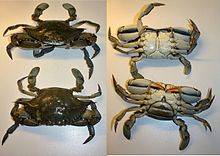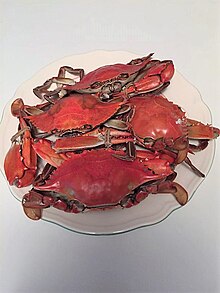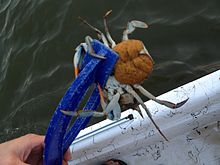Blue crab
| Blue crab | ||||||||||||
|---|---|---|---|---|---|---|---|---|---|---|---|---|

Blue crab ( Callinectes sapidus ) |
||||||||||||
| Systematics | ||||||||||||
|
||||||||||||
| Scientific name | ||||||||||||
| Callinectes sapidus | ||||||||||||
| Rathbun , 1896 |
The blue crab or blue swimming crab ( Callinectes sapidus ) belongs to the genus Callinectes in the family of swimming crabs (Portunidae). It is native to the western Atlantic , but was introduced into European waters in the 20th century. The scientific name is made up of the ancient Greek κάλλος kállos "beautiful", νηκτής nēktḗs "swimmer" and Latin sapidus "tasty".
features
The carapace (back armor) of the blue crab is between 17.8 and 20 centimeters wide and about 7.5 to 10.2 centimeters long. Males grow larger than females. The weight of adults is between 0.45 and 0.90 kilograms. The back armor has a dark brown, grayish, greenish or bluish-green color and has orange-colored spines or thorns with a width of up to 8 centimeters on each side. The lower legs and abdomen are whitish in color.
The scissors have different shades of color depending on their gender. The tips of the scissors of the males are bluish and those of the females are reddish in color. The sexes can also be differentiated using the abdominal flap or apron. In both sexes, the genital organs are hidden under the abdominal flap. In the male, the flap ( pleon ) under the abdomen is not suitable for carrying eggs and is therefore narrower and has the shape of an inverted T.
Like all decapods, the blue crab has five pairs of legs. The foremost pair of legs was transformed into two powerful claws in the course of evolution. The two scissors are of different sizes. The larger scissors are used to break open prey, while the smaller scissors transport food to the mouth. The fifth pair of legs is shaped like a paddle and is used for swimming. Like many decapods, blue crabs are capable of autotomy . The blue crab can regenerate lost limbs .
The short-stalked compound eyes lie directly below the front edge of the carapace on the head. There are two short and thin antennae between the eyes .
This species owes its common name to the blue coloring of the legs, which can also have white spots.
A blue crab is around two to four years old.
distribution
The original home of the blue crab is the Atlantic coast of North America and South America from Nova Scotia to Uruguay and the Gulf of Mexico . Today it is found as a neozoon in Japanese waters, the Baltic Sea , North Sea , the Mediterranean , the Adriatic and the Black Sea . The crab was probably introduced with ballast water . In Europe, the crab was first observed in 1901 in Rochefort (France).
The blue crab lives mainly in the estuaries of rivers and in shallow coastal waters to a depth of about 36 meters, and deeper in winter. It prefers muddy and sandy soils.
The young animals need a water temperature of 15 to 30 degrees Celsius. The adult animals can endure water temperatures of up to 10 degrees Celsius. In contrast to juveniles and adults, the larvae are sensitive to mean salt concentrations in the water, which are below 20 PSU .
Way of life
After mating, the females return to the shallow salty coastal waters while the males reside in estuaries.
It burrows itself in the mud or hides in seaweeds to ambush its prey or to protect itself from enemies. The blue crab is quite aggressive towards other species.
It is not an endangered species, but water pollutants from farms, sewage treatment plants and chemicals can have serious consequences for the blue crab, as these pollutants cause low oxygen levels, which it suffers greatly.
nutrition
The blue crab competes with other crustaceans ( Crustacea ) in foraging and eating. She is an omnivore. Their food spectrum includes thin-shelled mussels ( bivalvia ) such as B. mussels (Mytilidae), young crustaceans, fish , worms and plants. But it doesn't shy away from decaying carrion either. When food is scarce, she tends to be cannibalized.
Predators
The natural enemies include the red umberfish ( Sciaenops ocellatus ), the Atlantic umberfish ( Micropogonias undulatus ), the American herring gull ( Larus argentatus smithsonianus ), various species of herons (Ardeidae) and sea turtles (Cheloniidae).
Man has discovered the blue crab as a delicacy. Among other things, it is fished commercially in Greece. The annual catch is between 3.16 and 5.3 million kilograms, valued at US $ 1,928,000 to 4,474,000.
Parasites
An important parasite of the blue crab is Hematodinium perezi , a dinoflagellate . Also belonging to the microsporidia belonging Ameson michaelis and the amoeba Paramoeba pernicious able to high mortality lead. The nugget worm Microphallus basodactylophallus, which parse in the nerve tissue, and other microphallus species for which the blue crab is an intermediate host normally cause only minor damage. If the suction worm is infected by the hyperparasite Urosporidium crescens , this can lead to unsavory black discoloration after the kabbe is caught, which reduces its commercial value.
The ciliate Lagenophrys callinectes, which colonizes the gills, hardly damages the blue crab at low densities, but can lead to asphyxiation if it occurs in large numbers.
Reproduction
The blue crab becomes sexually mature at 12 to 18 months. The females mate only once, immediately after the last moult , while the males mate more often. Like all shellfish, the blue crab has to shed its skin at regular intervals because its shell does not grow with it.
After moulting, the female's shell is soft for a short time. The male uses this time to mate with the female. The female has the ability to store the male's sperm under her shell for a long time.
The female spawns approximately two to nine months after mating. The spawn consists of up to two million eggs. The spawning season begins in December and ends in October, with the peak in spring and summer. After the female has spawned, the eggs are fertilized with the stored sperm and placed on the tiny hair tags that are on her stomach.
The incubation period is about 14 days. Within two months, the larvae go through eight stages before they begin to look like crabs.
Subspecies
Animals from the southern part of the range, from Florida to the south, were described as Callinectes sapidus acutidens by the first descriptor of the species, the marine biologist Mary J. Rathbun, after Brazilian animals . Since both forms are connected by transitions and sometimes live side by side in the same habitat, the subspecies is usually no longer recognized today.
Economical meaning
Blue crabs have been an important species for commercial fishing in the entire area of the US east coast, but especially in the area of the Chesapeake Bay, at least since the beginning of European colonization of this region.
Individual evidence
- ↑ Species Fact Sheets: Callinectes sapidus (Rathbun, 1896) on the website of the Food and Agriculture Organization of the United Nations
- ^ A b A. Brockerhoff, C. McLay (2011): Human-mediated spread of alien crabs . In: Bella S. Galil, Paul F. Clark, James T. Carlton: In the Wrong Place - Alien Marine Crustaceans: Distribution, Biology and Impacts . Invading Nature, 6. Springer, Berlin / Heidelberg 2011. pp. 27-106., Callinectes sapidus : pp. 55f. ISBN 978-94-007-0590-6 .
- ↑ Gretchen A. Messick & Jeffrey D. Shields (2000): Epizootiology of the parasitic dinoflagellate Hematodinium sp. in the American blue crab Callinectes sapidus. Diseases of Aquatic Organisms 43: 139-152.
- ^ Gretchen A. Messick & Carl J. Sindermann: Synopsis of principal diseases of the blue crab, Callinectes sapidus. NOAA technical memorandum NMFS-F / NEC 88. NOAA National Oceanic and Atmospheric Administration, January 1992.
- ↑ JF Bridgman (1969): Life cycles of Carneophallus choanophallus n. Sp. and C. basodactylophallus n. sp. (Trematoda: Microphallidae). Tulane Studies in Zoology and Botany 15: 81-104.
- ^ Holly A. Rogers: Prevalence of Blue Crab (Callinectes sapidus) Diseases, Parasites, and Symbionts in Louisiana. Thesis, Louisiana State University, 2014. download ( memento of the original dated August 23, 2016 in the Internet Archive ) Info: The archive link was automatically inserted and not yet checked. Please check the original and archive link according to the instructions and then remove this notice.
- ^ Mark R. Millikin & Austin B. Williams: Synopsis of Biological Data on the Blue Crab, Callinectes sapidus Rathbun. NOAA Technical Report NMFS 1. NOAA National Oceanic and Atmospheric Administration, March 1984. PDF
- ↑ Callinectes sapidus acutidens Rathbun, 1896 at WoRMS World Register of Marine Species
- ↑ Warner, William W.,: Beautiful swimmers: watermen, crabs, and the Chesapeake Bay . First Back Bay ed. Boston 1994, ISBN 0-316-92335-4 .
swell
- Diverse: Grzimek's animal life. Lower animals. 1st vol. Deutscher Taschenbuch Verlag GmbH & Co.KG, Munich October 1993
- Hans-Echhard Gruner, Hans-Joachim Hannemann and Gerhard Hartwich, Urania Tierreich, 7 vols., Invertebrates, Urania, Freiburg, 1994




